In this tutorial, we’ll create an STM32 HAL GPIO Read Pin Example project. You’ll learn all the steps to configure the STM32 GPIO Input Pin Read Example in STM32CubeMX, flash the code from STM32CubeIDE to the blue pill STM32F103C8T6 board, and start testing with a push button & LED. Without further ado, let’s get right into it!
Table of Contents
- STM32 HAL GPIO Read Pin Example (hal_gpio_readpin)
- STM32 HAL GPIO Read Pin Example (CubeMX Configurations)
- STM32 HAL GPIO Read Pin Example Code Explained
- STM32 GPIO Input Example Testing
- Wrap Up
STM32 HAL GPIO Read Pin Example (hal_gpio_readpin)
Objectives of This STM32 HAL GPIO Read Pin Example Project:
- Configure GPIO Input & Output Pins Within CubeMX Tool
- Use HAL_GPIO_ReadPin() To Read The Input Push Button State
- Use HAL_GPIO_WritePin() To Change The Output Pin State
STM32 HAL GPIO Read Pin Example (CubeMX Configurations)
Step #1
Open STM32CubeMX, create a new project, and select the STM32F103C8T6 target microcontroller. Note that the STM32 BluePill board has two common target microcontrollers (STM32F103C8T6 & STM32F103C6T6). So you need to select the exact target microcontroller on your hardware board.
This example project should work flawlessly on any STM32 target microcontroller, you just need to select the target MCU that matches your hardware board.
Step #2
Go to the RCC clock configuration page and enable the HSE external crystal oscillator input.
Push Button Pin: Click on the PA9 GPIO pin and select it to be in GPIO_Input mode. Note: you can use any other pin you want instead.
LED Pin: Click on the PA8 GPIO pin in the “Pinout View” and select it to be in GPIO_Output mode. Note: you can use any other pin you want instead.
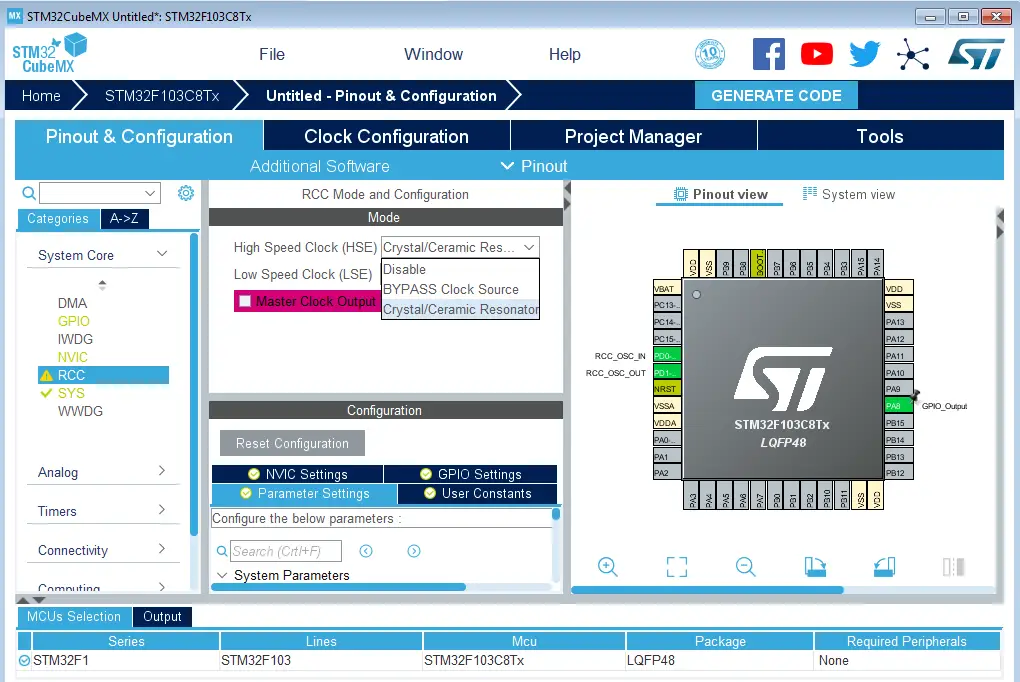
Step #3
Go to the clock configurations page, and select the HSE as a clock source, PLL output, and type in 72MHz for the desired output system frequency. Hit the “ Enter” key, and let the application solve for the required PLL dividers/multipliers to achieve the desired clock rate.
The reason behind this: using the external onboard oscillator on the BluePill board provides a more accurate and stable clock, and using a 72MHz as a system clock pushes the microcontroller to its limits, so we get the maximum performance out of it. As long as we don’t care about the application’s power consumption.
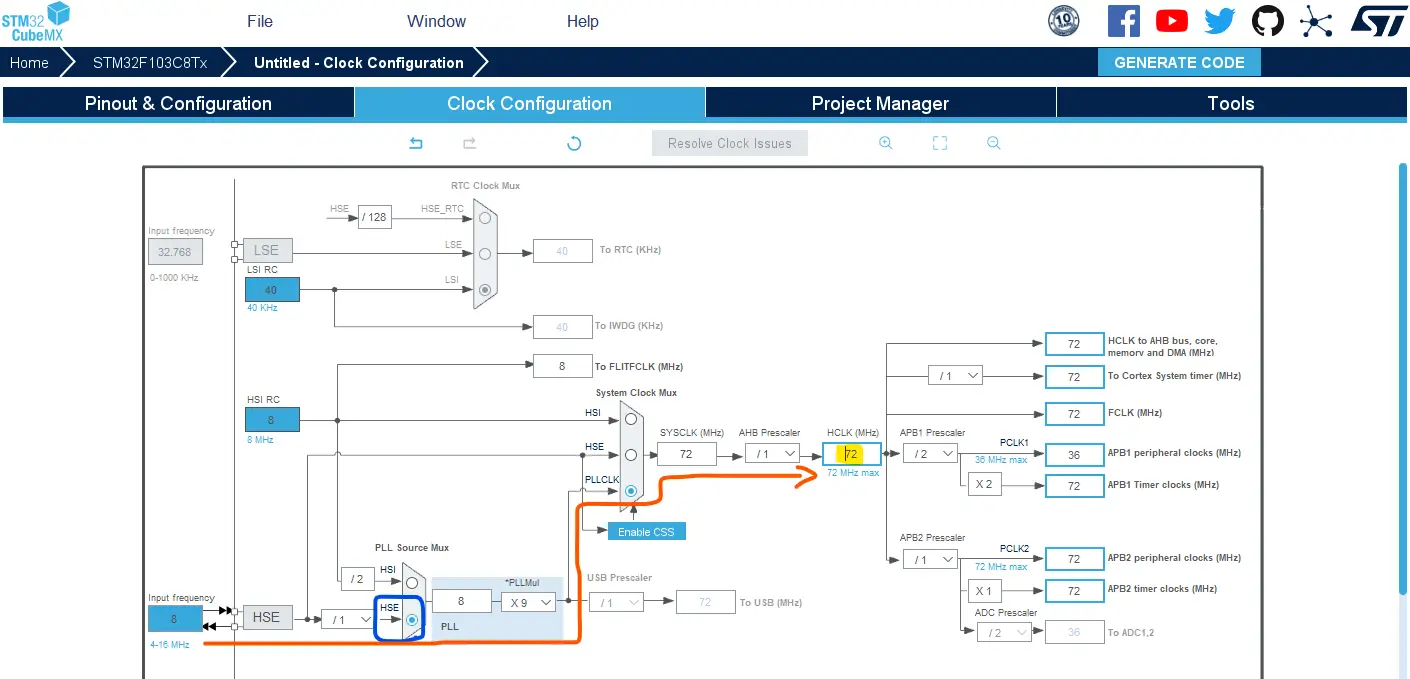
Step #4
Finally, go to the Project Manager, give your project a name, select the toolchain/IDE to be STM32CubeIDE, and click on the Generate Code button.
The STM32CubeMX tool will generate the initialization code & the project main files and it’ll prompt you to open the project in STM32CubeIDE. Select, open project, and let’s move to the next step.

Then, open the project in the IDE you’re using. And head over to the main.c file. So we can start writing the application code and have a look at the initialization code generated by the STM32 CubeMX tool.
Step #5
Copy the code below into your main.c file replacing the auto-generated code from the beginning of the fill till the main function. You should leave everything else under the main() function in the main.c file as is.
STM32 HAL GPIO Read Pin Example Code (HAL_GPIO_ReadPin)
|
1 2 3 4 5 6 7 8 9 10 11 12 13 14 15 16 17 18 19 20 21 |
int main(void) { HAL_Init(); SystemClock_Config(); MX_GPIO_Init(); while (1) { // IF Button Is Pressed if(HAL_GPIO_ReadPin (GPIOA, GPIO_PIN_9)) { // Set The LED ON! HAL_GPIO_WritePin(GPIOA, GPIO_PIN_8, GPIO_PIN_SET); } else { // Else .. Turn LED OFF! HAL_GPIO_WritePin(GPIOA, GPIO_PIN_8, GPIO_PIN_RESET); } } } |
STM32 HAL GPIO Read Pin Example Code Explained
The CubeMX tool has generated the initialization C-Code for us. There is nothing special about it except the GPIO init function shown down below.
|
1 2 3 4 5 6 7 8 9 10 11 12 13 14 15 16 17 18 19 20 21 22 23 24 |
static void MX_GPIO_Init(void) { GPIO_InitTypeDef GPIO_InitStruct = {0}; /* GPIO Ports Clock Enable */ __HAL_RCC_GPIOD_CLK_ENABLE(); __HAL_RCC_GPIOA_CLK_ENABLE(); /*Configure GPIO pin Output Level */ HAL_GPIO_WritePin(GPIOA, GPIO_PIN_8, GPIO_PIN_RESET); /*Configure GPIO pin : PA8 */ GPIO_InitStruct.Pin = GPIO_PIN_8; GPIO_InitStruct.Mode = GPIO_MODE_OUTPUT_PP; GPIO_InitStruct.Pull = GPIO_NOPULL; GPIO_InitStruct.Speed = GPIO_SPEED_FREQ_LOW; HAL_GPIO_Init(GPIOA, &GPIO_InitStruct); /*Configure GPIO pin : PA9 */ GPIO_InitStruct.Pin = GPIO_PIN_9; GPIO_InitStruct.Mode = GPIO_MODE_INPUT; GPIO_InitStruct.Pull = GPIO_NOPULL; // <----- This Option HAL_GPIO_Init(GPIOA, &GPIO_InitStruct); } |
As you can see, the input pin (A9) is set to Hi-Z or High-Impedance mode, it’s called no-pull (no pull-up or down). You can, however, set the pin to pull-up or pull-down depending on your preference.
We’ll head over again to the HAL documentation and search for the GPIO chapter, where we’ll find this listing for the available APIs. The APIs are hyperlinked in the documentation file, so you can click the name of the function to go directly to its detailed description.

So, let’s take a closer look at the HAL_GPIO_ReadPin() function.
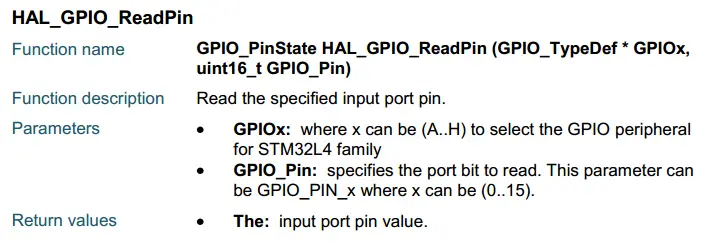
In this STM32 GPIO Read Input Pin Example, we’ve read the pin state for the push button (A9) and used it to drive the LED pin (A8) High or Low depending on the push button input pin state. It’s a very simple application and you can modify it as you want to meet your application’s needs. Let’s now move to the testing of this example project on a real STM32 blue pill board.
STM32 GPIO Input Example Testing
Step #1
Refer To The Blue Pill Board Schematic & Pinout
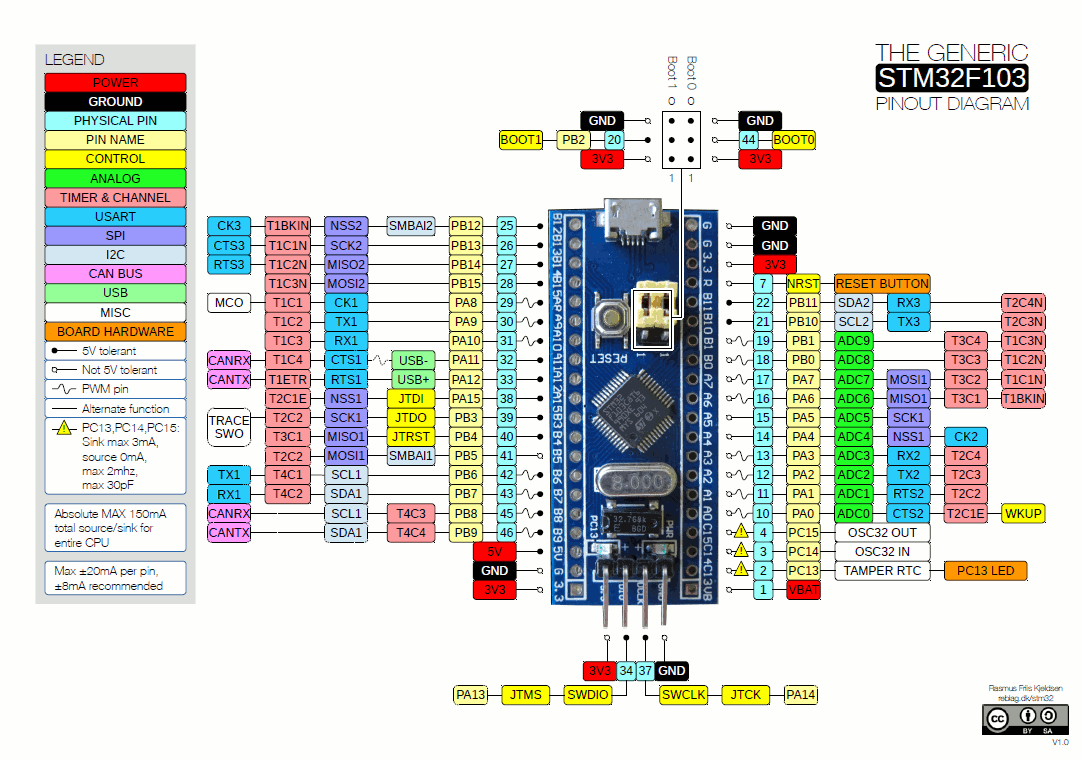
Step #2
Connect The ST-Link To The USB Port & SWD Pins On Board
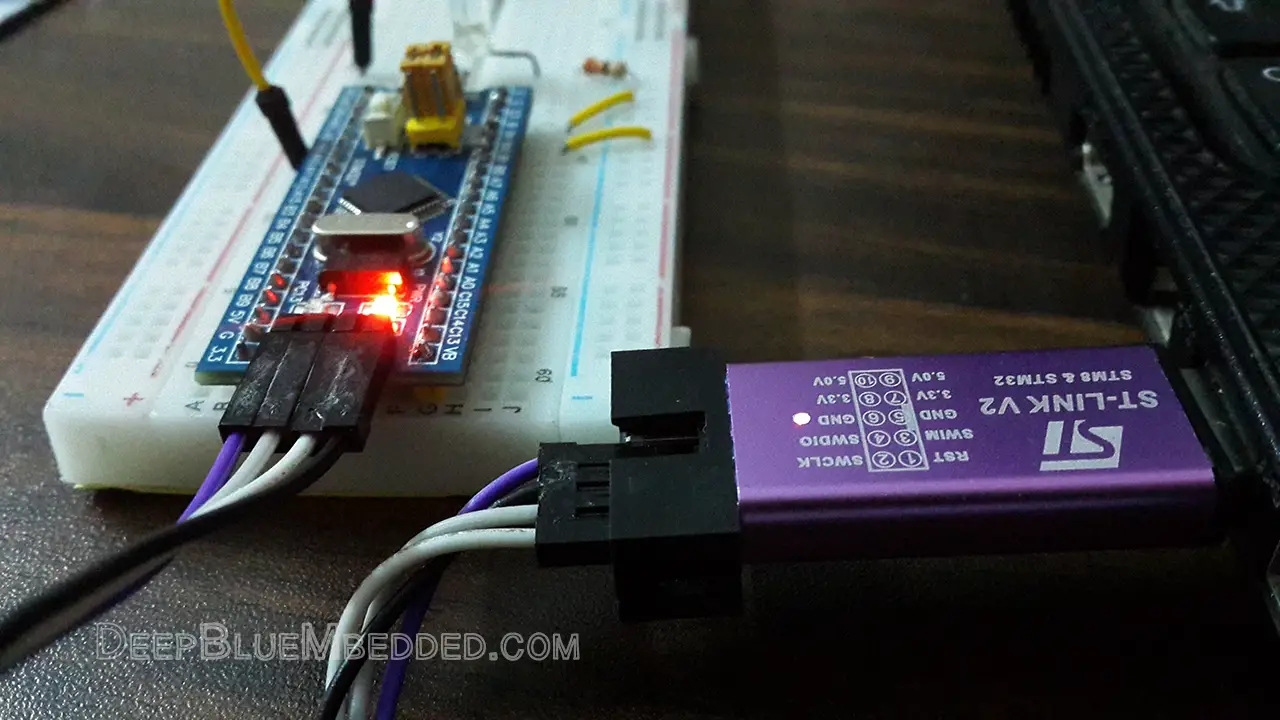
Step #3
Click The Debug Button To Compile The Code & Flash It To The Board & Start A Debugging Session
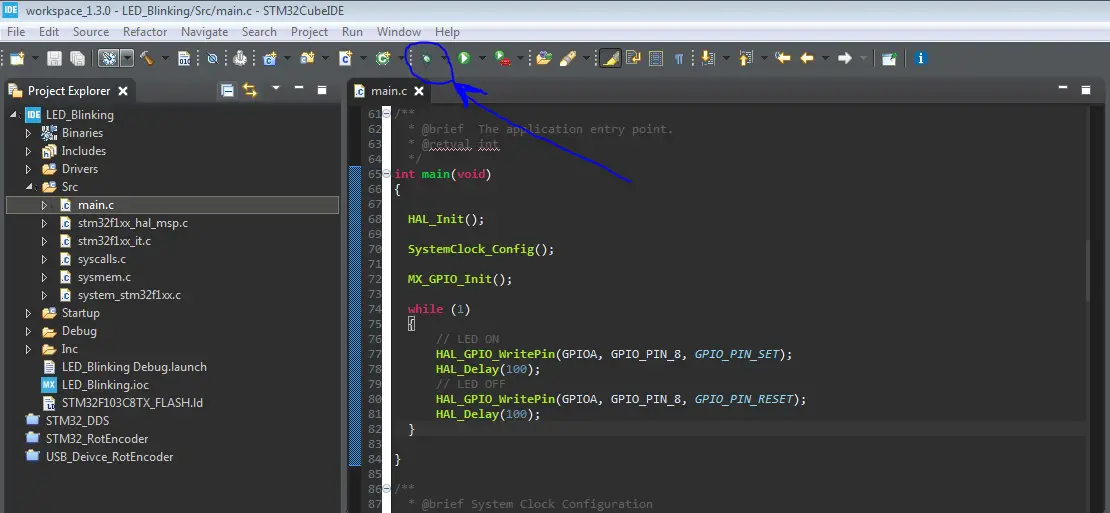
If the debugger GDB server returns an error to you over and over. Then, don’t try starting the debug session again. Until you move the BOOT0 pin jumper from 0 to logic 1. Then try debugging again, it should work just as fine. But don’t forget to set the BOOT0 pin back to 0 so it starts your application on start-up after restarting the microcontroller.
Step #4
You Can Stop The Debugging Session Or Keep It Going. But You Need To Restart The MCU Once To Run The New Application At The Booting Process.
Required Parts For STM32 Examples
All the example Code/LABs/Projects in this STM32 Series of Tutorials are done using the Dev boards & Electronic Parts Below:
| QTY. | Component Name | Amazon.com | AliExpress | eBay |
| 1 | STM32-F103 BluePill Board (ARM Cortex-M3 @ 72MHz) | Amazon | AliExpress | eBay |
| 1 | Nucleo-L432KC (ARM Cortex-M4 @ 80MHz) | Amazon | AliExpress | eBay |
| 1 | ST-Link V2 Debugger | Amazon | AliExpress | eBay |
| 2 | BreadBoard | Amazon | AliExpress | eBay |
| 1 | LEDs Kit | Amazon & Amazon | AliExpress | eBay |
| 1 | Resistors Kit | Amazon & Amazon | AliExpress | eBay |
| 1 | Capacitors Kit | Amazon & Amazon | AliExpress & AliExpress | eBay & eBay |
| 1 | Jumper Wires Pack | Amazon & Amazon | AliExpress & AliExpress | eBay & eBay |
| 1 | Push Buttons | Amazon & Amazon | AliExpress | eBay |
| 1 | Potentiometers | Amazon | AliExpress | eBay |
| 1 | Micro USB Cable | Amazon | AliExpress | eBay |
★ Check The Links Below For The Full Course Kit List & LAB Test Equipment Required For Debugging ★
Download Attachments
You can download all attachment files for this Article/Tutorial (project files, schematics, code, etc..) using the link below. Please consider supporting our work through the various support options listed in the link down below. Every small donation helps to keep this website up and running and ultimately supports the whole community.
Wrap Up
In conclusion, it was quite easy to create an STM32 GPIO input pin read example project to read a push button with the HAL_GPIO_ReadPin() function. You can play with different settings like adding multiple IO pins, and so on.
If you’re just getting started with STM32, you need to check out the STM32 Getting Started Tutorial here.
Follow this STM32 Series of Tutorials to learn more about STM32 Microcontrollers Programming.
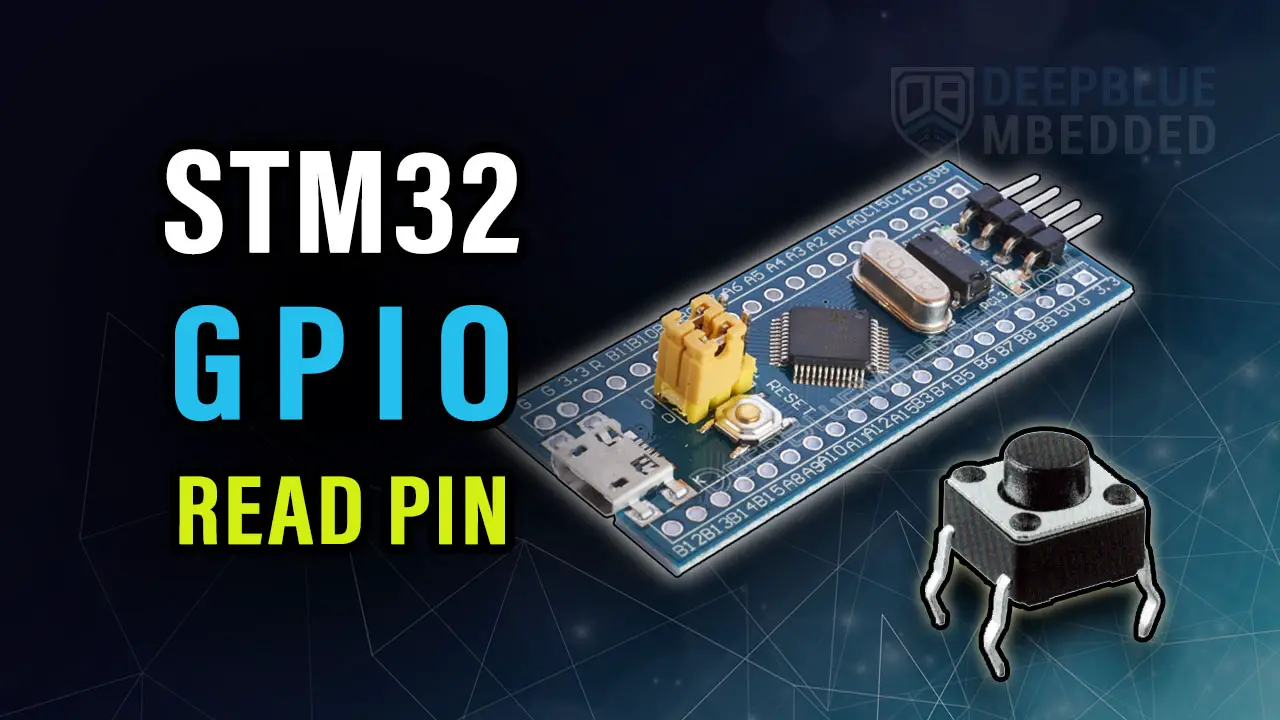

your tutorials are so nice. i have learned pic microcontrollers and now focusing on stm32.
it helps alot.
you should make youtube videos on these tutorials. that will be very helpful
thank you very much
Your teaching style is superb and your content is amazing.
Thanks a lot for all of your effort.
God Bless you